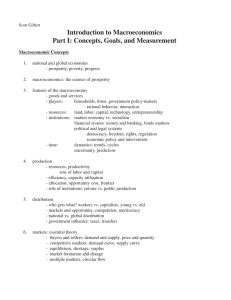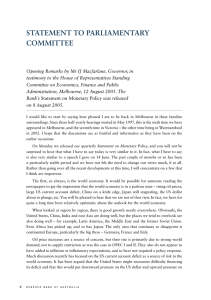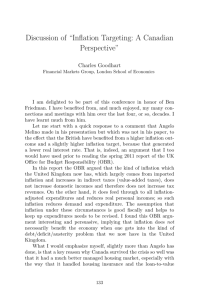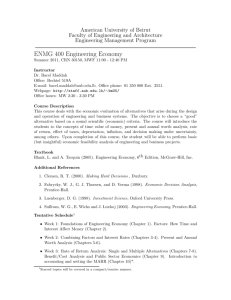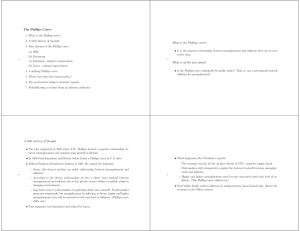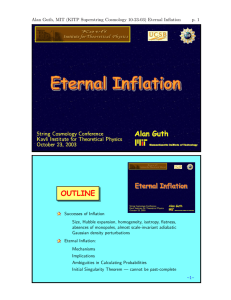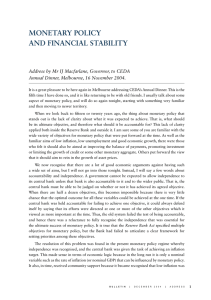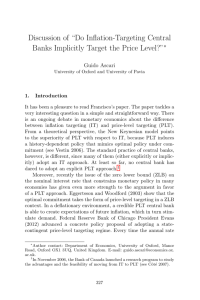Woodford’s Approach to Robust Policy Analysis in a Linear-Quadratic Framework ∗ Hyosung Kwon
advertisement
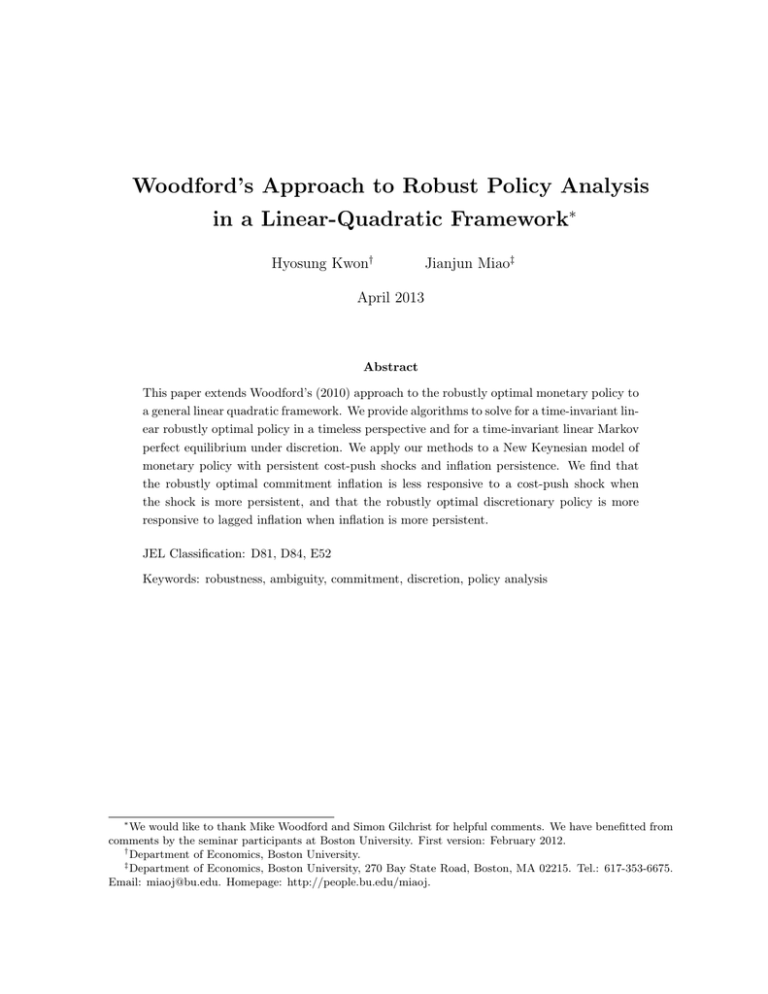
Woodford’s Approach to Robust Policy Analysis
in a Linear-Quadratic Framework∗
Hyosung Kwon†
Jianjun Miao‡
April 2013
Abstract
This paper extends Woodford’s (2010) approach to the robustly optimal monetary policy to
a general linear quadratic framework. We provide algorithms to solve for a time-invariant linear robustly optimal policy in a timeless perspective and for a time-invariant linear Markov
perfect equilibrium under discretion. We apply our methods to a New Keynesian model of
monetary policy with persistent cost-push shocks and inflation persistence. We find that
the robustly optimal commitment inflation is less responsive to a cost-push shock when
the shock is more persistent, and that the robustly optimal discretionary policy is more
responsive to lagged inflation when inflation is more persistent.
JEL Classification: D81, D84, E52
Keywords: robustness, ambiguity, commitment, discretion, policy analysis
∗
We would like to thank Mike Woodford and Simon Gilchrist for helpful comments. We have benefitted from
comments by the seminar participants at Boston University. First version: February 2012.
†
Department of Economics, Boston University.
‡
Department of Economics, Boston University, 270 Bay State Road, Boston, MA 02215. Tel.: 617-353-6675.
Email: miaoj@bu.edu. Homepage: http://people.bu.edu/miaoj.
1.
Introduction
The traditional policy analysis has been typically conducted under the rational expectations
hypothesis. While we have learned many lessons from this hypothesis, there are several good
reasons for us to think about departures from it. First, the Ellsberg (1961) paradox and related
experimental evidence demonstrate that there is a distinction between risk and ambiguity.
Risk refers to the situation where there is a known probability distribution over the state of
the world, while ambiguity refers to the situation where the information is too vague to be
adequately summarized by a single probability distribution. As a result, a decision maker may
have multiple priors in mind (Gilboa and Schmeidler (1989)). Second, as Anderson, Hansen and
Sargent (2003) and Hansen and Sargent (2001, 2008) point out, economic agents view economic
models as an approximation to the true model. They believe that economic data come from an
unknown member of a set of unspecified models near the approximating model. Concern about
model misspecification induces a decision maker to want robust decision rules that work over
that set of nearby models.1
The above arguments are especially relevant for policy analysis in which uncertainty and
expectations play an important role. Either the policymaker or the private agents may not have
complete confidence in the likelihood of the state of the world and hence face model ambiguity.
Several possibilities may arise.2 First, the policymaker does not trust its approximating model,
but the private agents do. The policymaker forms expectations using a model in a set of nearby
models surrounding its approximating model. Hansen and Sargent (2003 and 2008, Chapter
16) study this case. Woodford (2010) studies a second case in which the policymaker trusts its
approximating model, but it has ambiguity about the private agents’ beliefs about the model.
The policymaker thinks that the private agents may form expectations using any model in a set
of nearby models surrounding the policymaker’s approximating model. The Hansen-Sargent
approach seems well understood and several computation algorithms in the linear-quadratic
framework have been proposed in the literature (e.g., Hansen and Sargent (2008), Giordani
and Soderlind (2008), Dennis (2008), Leitemo, and Soderstrom (2009)). However, little is
known about how to conduct robust policy analysis using the Woodford approach in a general
linear-quadratic framework.
This paper fills this gap by proposing algorithms for solving robustly optimal policy under
both timeless perspective commitment and discretion. Our algorithms borrow insights from
1
There is a growing literature on the applications of robustness and ambiguity to finance and macroeconomics,
e.g., Epstein and Wang (1994); Hansen (2007); and Ju and Miao (2012); among others.
2
See Hansen and Sargent (2012) for a discussion of different types of ambiguity.
1
Woodford (2010), who derives analytical solutions for a basic New Keynesian model. We
focus on conditionally linear policy rules under timeless perspective commitment and linear
Markov perfect equilibria (MPE) under discretion. We show that robustly optimal conditionally
linear policy and a linear Markov perfect equilibrium can exist given certain conditions. Our
algorithms then reduce to solving for linear decision rules using tools from the literature on
solving linear rational expectations models and linear-quadratic control problems.
We apply our algorithms to a New Keynesian model with a persistent cost-push shock and
inflation persistence. The Woodford (2010) model is a special case of our model. We confirm
Woodford’s (2010) major findings for the case of purely temporary shocks that (i) the robustly
optimal inflation is less responsive to the current cost-push shock, and (ii) the robustly optimal
inflation is more history-dependent compared to the case of rational expectations. We also find
some new comparative statics results: (i) When the cost-push shock becomes more persistent,
robustly optimal inflation is less responsive to it, but the robustly optimal output gap is more
responsive. By contrast, optimal inflation under rational expectations is more responsive to
a cost-push shock when it is more persistent. (ii) In addition, the robust discretionary policy
becomes more costly and the range of parameters for the existence of a linear MPE shrinks.
(iii) When the steady state is more inefficient, the robustly optimal inflation is less responsive
to the cost-push shock.
As Woodford (2010) points out, the central bank is not willing to let inflation increase
in response to a positive cost-push shock when it is faced with a concern for robustness. The
central bank fears that a large shock in inflation might affect the inflation expectation of private
agents unfavorably to the central bank and thus the output-inflation trade-off might worsen if
it allows inflation to increase. Naturally, the central bank’s concern for the unfavorable change
in the private agents’ forecast becomes larger when the cost-push shock is more persistent. As
a result, the central bank is more conservative in setting the optimal inflation rate. If the shock
is as highly persistent as a unit root process, the central bank commits to an inflation rate
which does not depend on the current shock.
In our model, the New Keynesian Phillips curve contains lagged inflation. The lagged
inflation rate is an endogenous state variable and hence the method in Woodford (2010) cannot
be applied. Using our algorithms, we find the following new results: (i) When the degree
of inflation inertia is larger, the sensitivities to the contemporaneous cost-push shock of both
the robustly optimal commitment and discretionary policies are closer to those under rational
expectations. In this case, the impact of the belief distortion from the private sector is smaller
as a smaller weight is attached to the expected inflation. (ii) The robustly optimal discretionary
2
policy is more sensitive to lagged inflation than the optimal discretionary policy under rational
expectations. This sensitivity increases as the volatility of the cost-push shock increases. This is
in contrast to the case of rational expectations under which the optimal discretionary inflation
responds to lagged inflation by the same degree regardless of the size of the shock volatility. The
intuition is that, without commitment, the inflation bias is larger with concerns for robustness
than in the case of rational expectations. Under the worst-case beliefs, inflation expectations
are biased upward, and hence a discretionary central bank has a greater incentive to respond
to both the current shock and lagged inflation.
The remainder of the paper proceeds as follows. Section 2 presents the general framework.
Section 3 presents an algorithm for solving robustly optimal policy in a timeless perspective.
Section 4 provides an algorithm for solving robustly optimal discretionary policy. Section 5
analyzes a monetary policy example. Section 6 concludes. Technical details are relegated to
appendices.
2.
A Linear-Quadratic Framework
2.1.
Uncertainty and Beliefs
Uncertainty is generated by a stochastic process of shocks {εt }∞
t=0 where εt is an nε × 1
vector of independently and identically distributed standard normal random variable. Let
εt = {ε0 , ε1 , ..., εt } . At date t, both the policymaker and the private sector have common information generated by εt and some initial state x0 . They may not have rational expectations in
that their subjective beliefs may not coincide with the objective probability distribution governing exogenous shocks {εt }∞
t=0 . One reason is that economic agents view their model as an
approximation and thus may be concerned about model misspecification.
Model misspecification is described by a perturbation to the distribution of shocks. Let
p (ε) denote the standard normal density of εt . Let P and Pt denote the induced distribution
over the full state space and the induced joint distribution of εt , respectively. Assume that a
distorted distribution is absolutely continuous with respect to the reference distribution P. We
can then represent belief distortions by Radon-Nikodym derivatives.
(
)
Let p̂ ε|εt , x0 denote an alternative one-step-ahead density for εt+1 conditioned on date
t information. Form the likelihood ratio or the Radon-Nikodym derivative for one-step-ahead
distributions:
mt+1
(
)
p̂ ε|εt , x0
=
.
p (ε)
3
It satisfies the property
Et [mt+1 ] = 1,
(1)
where Et denotes the conditional expectation operator for the reference distribution P given
date t information. Inspired by Hansen and Sargent (2001, 2008), Woodford (2010) uses conditional relative entropy to measure the discrepancy between the distorted distribution and
the reference distribution. He first constructs the conditional relative entropy of a one-stepahead distribution given date t information as Et [mt+1 ln mt+1 ]. He then defines the expected
discounted entropy conditioned on date zero information as
E0
∞
∑
t
β [Et (mt+1 ln mt+1 )] = E0
t=0
∞
∑
β t mt+1 ln mt+1 .
(2)
j=0
Model ambiguity is described by a set of one-step-ahead densities {mt }∞
t=1 satisfying the constraint:
E0
∞
∑
β t mt+1 ln mt+1 ≤ η 0
(3)
t=0
for some η 0 > 0.
2.2.
Robustly Optimal Policy Problem
Suppose that the equilibrium system from the private sector can be summarized by the following
form:
[
I
0
D21 D22
][
xt+1
Êt yt+1
]
[
= Â
xt
yt
]
[
+ B̂ut +
bx
C
0
]
εt+1 ,
(4)
where x0 is exogenously given and Êt denotes the conditional expectation operator given date t
information based on the common beliefs of the private sector. The private sector’s beliefs may
not coincide with the “objective” probability distribution for {εt } , the reference distribution
P. Here xt is an nx × 1 vector of predetermined variables in the sense defined in Klein (2000),
yt is an ny × 1 vector of non-predetermined or forward-looking variables, and ut is an nu × 1
vector of instrument or control variables chosen by the policymaker. We typically use xt to
represent the state of the economy, which may include productivity shocks, preference shocks,
or capital stock. Note that xt may include a component of unity in order to handle constants.
The vector yt represents endogenous variables such as consumption, inflation rate, and output.
4
Examples of instruments ut include interest rates and money growth rates. The equation
for xt is backward-looking and represents the law of motion of state variables. The equation
for yt is forward-looking and typically represents the first-order conditions from intertemporal
optimization, such as Euler equations.
All matrices in (4) are conformable. For simplicity, we suppose that the matrix on the left
side of equation (4) is invertible so that we can multiply both sides of this equation by its
inverse to obtain the system:3
[
]
xt+1
[
xt
=A
Êt yt+1
]
yt
+ But + Cεt+1 ,
(5)
where we have used the shorthand notation,
[
A≡
Axx Axy
]
[
, B≡
Ayx Ayy
Bx
]
[
, C≡
By
]
Cx
,
0
and where we have partitioned matrices conformably.
The policymaker has the period loss function,
1 [ ′ ′]
L (xt , yt , ut ) =
x ,y
2 t t
[
Qxx , Qxy
Q′xy
][
xt
Qyy
yt
]
[
]
1
+ u′t Rut + x′t , yt′
2
[
Sx
Sy
]
ut ,
where we assume the matrix
Qxx Qxy Sx
′
Qxy
Sx′
Qyy
Sy′
Sy ,
R
is symmetric and positive semidefinite.
If both the private sector and the policymaker have rational expectations, then they have
common beliefs which coincide with P, the probability distribution governing exogenous shocks
{εt } . In this case, the optimal policy problem with commitment is given by
max
{xt ,yt ,ut }
− E0
∞
∑
β t L (xt , yt , ut ) ,
(6)
t=0
subject to (5) in which the conditional expectation operator Êt is equal to Et , the conditional
expectation operator with respect to P.
3
The singular case can be handled by the QZ decomposition method, e.g., Klein (2000) and Sims (2002).
5
Following Woodford (2010), we suppose that the policymaker has a single model of the
exogenous processes {εt } and thus no ambiguity along this dimension. Nevertheless, the policymaker faces ambiguity because it knows only that the private sector’s model is within a set of
probability models surrounding its own model. The policymaker evaluates the private sector’s
forward-looking equation using a worst-case model and solves the following problem:
max
min
{xt ,yt ,ut } {mt+1 }
− E0
∞
∑
β t L (xt , yt , ut ) + θE0
∞
∑
β t mt+1 ln mt+1 ,
(7)
t=0
t=0
subject to (1) and
[
xt+1
]
Et [mt+1 yt+1 ]
[
=A
xt
yt
]
+ But + Cεt+1 .
(8)
Here the parameter θ > 0 penalizes one-step-ahead densities {mt } with large relative entropies
defined in (2). It may be regarded as the Lagrange multiplier for the constraint (3). Following
Hansen and Sargent (2001, 2008), instead of solving for the constraint problem subject to
(3), we treat θ as a parameter, which measures the policymaker’s degree of concern for possible
departures from rational expectations, with a small value of θ implying a great degree of concern
for robustness, while a large value of θ implies that only modest departures from rational
expectations are considered plausible. When θ → ∞, the rational expectations analysis is
obtained as a limiting case.
3.
Commitment in a Timeless Perspective
Instead of solving for an optimal commitment policy,4 Woodford (2010) uses a timeless perspective to derive a closed-form solution to a robustly optimal monetary policy problem in a simple
New Keynesian model. We now extend his idea to our general formulation. We replace E0 in
(7) with E−1 , the conditional expectation operator given the economy’s state at date −1, i.e.,
before the realization of the period zero state x0 or implied ε0 . Instead of supposing that the
policymaker chooses a sequence of (possibly time-varying) {yt } for all t ≥ 0, we consider only
the problem of choosing an optimal sequence of commitments {yt } for periods t ≥ 1, taking as
given a commitment y0 that the policymaker must fulfill.
Suppose that the initial commitment takes a linear form:
y0 = Φ−1 + Γ−1 ε0 ,
4
Kwon and Miao (2012) study this type of policy in models with three types of ambiguity.
6
for some coefficients (Φ−1 , Γ−1 ) . Suppose that {yt } chosen for periods t ≥ 1 may depend on
(Φ−1 , Γ−1 ) and shocks from periods zero through t. We focus on conditionally linear rules of
the following form:
yt+1 = Φt + Γt εt+1 , t ≥ 0,
(9)
where Φt is stochastic and measurable with respect to date t information and Γt is deterministic.
For any initial commitment (Φ−1 , Γ−1 ) , the policymaker chooses (Φt , Γt )t≥0 , {xt , mt }t≥1 , and
{ut }t≥0 to solve problem (7).
To define optimal policy from a timeless perspective, suppose that Φ−1 is drawn from some
distribution ρ. The initial commitment (Φ−1 , Γ−1 ) is self-consistent if the solution to the robust
Ramsey policy is such that (i) Γt = Γ−1 and (ii) the unconditional distribution of ρt for Φt is
equal to ρ, for each t ≥ 0. Our goal is to solve for a conditionally linear robustly optimal policy
with a self-consistent initial commitment.5
Form the Lagrangian expression:
{
∞
∑
t
E−1
β − L (xt , yt , ut ) + θmt+1 ln mt+1 − ϕt (Et mt+1 − 1)
t=0
[
− µ′xt+1 , µ′yt
]
([
xt+1
Et mt+1 yt+1
]
[
−A
xt
yt
]
)}
− But − Cεt+1
,
[
]
where β t ϕt and β t µ′xt+1 , µ′yt are vectors of Lagrange multipliers associated with the constraints (1) and (8), respectively. Note that µxt+1 is measurable with respect to date t + 1
information and corresponds to xt+1 , but µyt is measurable with respect to date t information
and corresponds to yt .
The first-order conditions with respect to mt+1 are given by
θ(1 + ln mt+1 ) − ϕt − µ′yt yt+1 = 0.
(10)
Substituting the linear form in (9) into the above equation yields:
ln mt+1 = −1 + θ−1 ϕt + θ−1 µ′yt (Φt + Γt ϵt+1 ).
(11)
Since Γt , Φt , µyt , ϕt are measurable with respect to the date t information, mt+1 follows a
log-normal distribution conditioned on date t information. Using equation (1), we can show
5
See Woodford (2003, Chapter 7) for the concept of self-consistency under rational expectations.
7
that the worst-case density is given by
mt+1
)
(
1 −2 ′
′
−1 ′
= exp − θ µyt Γt Γt µy t + θ µyt Γt ϵt+1 .
2
(12)
This implies that under the worst-case belief, the shock εt follows a normal distribution with
′
mean θ−1 Γt µyt and covariance matrix I.
Under the worst-case belief, the conditional expectation of yt+1 is given by
Et mt+1 yt+1 = Φt + θ−1 Γt Γ′t µyt ,
(13)
and the conditional relative entropy is given by
1
Et mt+1 ln mt+1 = θ−2 µ′yt Γt Γ′t µyt .
2
(14)
Since Et yt+1 = Φt , it follows that, relative to the policymaker’s expectations, the worst-case
beliefs distort the private agents’ expectations by θ−1 Γt Γ′t µyt .
Now substitute equations (13) and (14) into the Lagrangian to obtain
{
1
E−1
β −L(xt , Φt−1 + Γt−1 ϵt , ut ) + θ−1 µ′yt Γt Γ′t µyt
2
t=0
([
)}
]
[
]
[ ′
]
xt+1
xt
′
− µxt+1 , µyt
−A
− But − Cεt+1
Φt + θ−1 Γt Γ′t µyt
Φt−1 + Γt−1 ϵt
∞
∑
t
The first-order conditions with respect to xt , ut , Φt , and Γt are given by6
xt : 0 = −Qxx xt − Qxy (Φt−1 + Γt−1 ϵt ) − Sx ut − β −1 µxt + A′xx Et µxt+1 + A′yx µyt ,
(15)
ut : 0 = −Rut − Sx′ xt − Sy′ (Φt−1 + Γt−1 ϵt ) + Bx′ Et µxt+1 + By′ µyt ,
(16)
)
[
]
(
Φt : 0 = − Q′xy Et xt+1 + Qyy Φt − Sy Et ut+1 − β −1 µyt + Et A′xy µxt+2 + A′yy µyt+1 , (17)
6
For any scalar function f (X) of a
∂f (X)
(X)
... ∂f
∂x1k
∂f (X)
∂x11
= ...
∂X
∂f (X)
(X)
... ∂f
∂xn1
∂xnk
n × k matrix X = (xij ), we define the derivative
.
n×k
8
Γt : 0 = − βQ′xy Et xt+1 ϵ′t+1 − βQyy Et (Φt + Γt ϵt+1 ) ϵ′t+1 − βSy Et ut+1 ϵ′t+1
)
[(
]
− θ−1 µyt µ′yt Γt + βEt A′xy µxt+2 + A′yy µyt+1 ϵ′t+1 .
(18)
Plugging (9), (13) and (14) into (8) yields:
0 = xt+1 − Axx xt − Axy (Φt−1 + Γt−1 ϵt ) − Bx ut − Cx ϵt+1 ,
(19)
θ−1 Γt Γ′t µyt + Φt − Ayx xt − Ayy (Φt−1 + Γt−1 ϵt ) − By ut = 0.
(20)
Since we focus on self-consistent optimal policy, we assume that Γt = Γ for all t. We start
{
}
with an initial guess of Γ and then solve for xt , ut , Φt , µxt , µyt given this guess. Equations
(15), (16), (17), (19), and (20), together with two identity equations, Et εt+1 = 0 and Et µxt+1 =
Et µxt+1 , form a linear system of the following form:
J
Et εt+1
Et xt+1
Φt
Et ut+1 = F
Et µyt+1
Et µxt+1
Et µxt+2
εt
xt
Φt−1
ut
µyt
µxt
,
(21)
Et µxt+1
where
I
0
0
J = 0
0
0
0
0
0
0
0
0
0
0
0
I
I
0
0
0
0
0
I
0
0
0
0
0
0
0
A′xx
0
0
0
0
Bx′
0 Q′xy Qyy Sy −A′yy
0
0
0
0
0 ,
0
0
−A′xy
9
and
0
0
0
0
0
0
0
0
0
0
0
0
I
0
Axy Γ Axx Axy Bx
0
0
0
F = Ayy Γ Ayx Ayy By −θ−1 ΓΓ′
0
0 .
−1
′
Qxy Γ Qxx Qxy Sx
−A
β
I
0
yx
′
Sx′
Sy′
R
−By′
0
0
Sy Γ
0
0
0
0
−β −1 I
0
0
Here εt , xt and Φt−1 are predetermined variables, and ut , µyt , µxt and Et µxt+1 are nonpredetermined variables.7 Adapting a standard method for solving linear rational expectations
models (e.g., Klein (2000)), we can show in Appendix A that the solution takes the following
state space representation:8
εt+1
εt
I
xt+1 = M xt + Cx εt+1 .
Φt
Φt−1
0
(22)
and
ut
µyt
µxt
Et µxt+1
=N
εt
xt
,
(23)
Φt−1
where the first row of M contains zero elements.
For Φt to have an invariant distribution, (22) should be a stationary process, which can be
satisfied if M has all eigenvalues inside the unit circle. We assume this condition is satisfied.
After deriving the state space representation, we can derive an updated value for Γ using
(18). When θ is finite, the presence of the term β −1 θ−1 µyt µ′yt Γt in (18) implies that the
solution for Γ may be time varying. The timeless perspective discussed in Woodford (2010)
solves this issue. Since the optimal policy in the timeless perspective should satisfy (18) for
every realization of the initial commitment, Φ−1 , we can take unconditional expectations on
7
In our solution, the non-predetermined variable yt in the equilibrium system from the private sector is
rewritten using predetermined variables (Φt−1 , εt ). Thus, the Lagrange multiplier µyt associated with yt becomes
a non-predetermined variable.
8
Note that the system in (21) does not fit exactly in Klein’s (2000) general form.
10
both sides of (18) to derive
9
(
[
)−1
]
Γ = β θ−1 E µyt µ′yt + βQyy
{ [(
]
[
]}
)
× E A′xy µxt+2 + A′yy µyt+1 ϵ′t+1 − Q′xy Cx − Sy E ut ϵ′t ,
(24)
where we have assumed that the inverse exists. In Appendix B, we derive formulas for comput[
]
[
]
[
]
ing unconditional moments E µyt µ′yt , E µxt+2 ϵ′t+1 , E µyt+1 ϵ′t+1 , and E [ut ϵ′t ]. The above
equation gives an updated solution for Γ denoted by Γ̂. If Γ̂ is sufficiently close to Γ, stop. Otherwise, use Γ̂ to replace Γ and repeat the above procedure until convergence. We are unable
to give a condition to guarantee convergence. But this algorithm works well for all examples
studied in this paper.
From the above analysis, we find that the robustness parameter θ appears explicitly in two
[
]
terms only: one is −θ−1 ΓΓ′ in the matrix F and the other is θ−1 E µyt µ′yt in equation (24). In
the limit as θ → ∞, both terms vanish and the solution converges to the rational expectations
case. When θ is smaller, the impact of robustness is larger. In addition, the impact of robustness
[
]
on Γ depends on the moment E µyt µ′yt for any fixed finite value of θ. These observations are
important for understanding the intuition behind the examples analyzed later.
4.
Robust Discretionary Policy
To understand the value and importance of policy commitment, we now study robust discretionary policy. In this case, the policymaker reoptimizes every period by taking the private
agents’ expectations about future policy as given. We shall focus on Markov perfect equilibrium (MPE). A robust MPE consists of time-invariant functions f (xt ) and V (xt ) such that
given yt+1 = f (xt+1 ) , V (xt ) and yt = f (xt ) solve the following Bellman equation:
V (xt ) = max min
yt ,ut mt+1
− L (xt , yt , ut ) + βEt V (xt+1 ) + θEt mt+1 ln mt+1 ,
(25)
subject to (1) and (8).
We focus on linear solutions for f in that
yt = Gxt , for all t,
(26)
for some matrix G to be determined. Adapting the method from the rational expectations
9
Note that taking unconditional expectations on other first-order conditions, i.e. (15)∼(17), does not add
additional information to the solution.
11
analysis (e.g., Backus and Driffil (1986) and Soderlind (1999)), we use an iterative procedure
to find G by backward induction. Specifically, let
yt+1 = Gt+1 xt+1 ,
(27)
where Gt+1 is a deterministic matrix. Substituting this expression into the forward-looking
equation in (8) and rewrite the Bellman equation (25) as
Vt (xt ) = max min
yt ,ut mt+1
− L (xt , yt , ut ) + βEt Vt+1 (xt+1 ) + θEt mt+1 ln mt+1 .
(28)
We can show that the first-order condition with respect to mt+1 is given by (10), where ϕt
and µyt are the Lagrange multipliers associated with (1) and the forward-looking equation in
(8), respectively. Using equations (1), (8), (10), (26) we can show that
mt+1
(
)
1 −2 ′
′ ′
−1 ′
= exp − θ µyt Gt+1 Cx Cx Gt+1 µy t + θ µyt Gt+1 Cx ϵt+1 .
2
It follows that mt+1 follows a log-normal distribution conditioned on date t information. We
can then compute
1
Et mt+1 ln mt+1 = θ−1 µ′yt Λt+1 µyt ,
2
Et mt+1 yt+1 = Gt+1 (Axx xt + Axy yt + Bx ut ) + Λt+1 µyt ,
(29)
(30)
where we define Λt+1 ≡ θ−1 Gt+1 Cx Cx′ G′t+1 . Since Et yt+1 = Gt+1 (Axx xt + Axy yt + Bx ut ) , the
worst-case beliefs distort the private agents’ expectations by Λt+1 µyt , relative to the policymaker’s expectations.
Substituting (30) into (8) yields:
Gt+1 (Axx xt + Axy yt + Bx ut ) + Λt+1 µyt = Ayx xt + Ayy yt + By ut .
(31)
Conjecture that
1
1
Vt (xt ) = − x′t Jt xt − vt ,
2
2
where Jt is a deterministic matrix and vt is a deterministic constant. Substituting the conjecture
12
and (29) into the Bellman equation (28) yields:
1
1
1
1
− x′t Jt xt − vt = max − x′t Qxx xt − yt′ Qyy yt − x′t Qxy yt
yt ,ut
2
2
2
2
1 ′
− ut Rut − x′t Sx ut − yt′ Sy ut
2
(
)
1 ′
1
1 ′
+ µyt Λt+1 µyt + βEt − xt+1 Jt+1 xt+1 − vt+1 ,
2
2
2
(32)
subject to (31) and
xt+1 = Axx xt + Axy yt + Bx ut + Cx εt+1 ,
where the Lagrange multiplier µyt is associated with (31). The above problem is a standard
linear quadratic control problem with state variable xt and control variables ut and yt . In
Appendix C, we solve for Jt , vt and linear decision rules of the following form:
ut = −Ft xt , yt = Gt xt .
To find the time-invariant functions, we start with an initial guess of a positive semi-definite
matrix Jt+1 , a constant vt+1 , and any matrix Gt+1 . We then obtain the updated constant vt
and matrices Jt and Gt . Iterating this process until convergence gives J and G in a Markov
perfect equilibrium. In addition, vt converges to v in the value function and Ft converges to F ,
which gives the stationary policy rule. Note that since a MPE is a fixed point, there may be
multiple equilibria or no equilibrium. For the simple New Keynesian model, Woodford (2010)
provides explicit characterizations. But a similar characterization for our general model is not
available.
5.
Applications to Monetary Policy
In this section, we apply our general theory to the study of robustly optimal monetary policy
in a New Keynesian model. The central bank’s loss function is given by
E−1
∞
∑
t=0
βt
]
1[ 2
π t + λ(xt − x∗ )2 ,
2
(33)
where π t denotes the inflation rate, xt denotes the output gap, and x∗ ≥ 0 denotes the target
output gap. The value of x∗ measures the degree of inefficiency of the steady state. If x∗ = 0,
the steady state is efficient. The parameter λ measures the weight to the output gap.
13
Empirical studies find evidence that inflation is persistent (e.g., Fuhrer (1996)). Thus,
suppose that the New Keynesian Phillips curve (NKPC) is given by
π t = κxt + ηπ t−1 + β(1 − η)Et mt+1 π t+1 + zt ,
(34)
where η ∈ (0, 1) measures the degree of backward-looking behavior exhibited by inflation.10
Assume that κ > 0 and {zt } follows an AR(1) process:
zt = ρz zt−1 + σ z εt ,
εt ∼ N (0, 1),
(35)
where ρz ∈ (0, 1) and σ z > 0. When η = 0, the model reduces to the basic New Keynesian
model studied by Woodford (2010). When η ∈ (0, 1), Woodford’s (2010) analytical method
does not apply because the lagged inflation rate provides another state variable.
5.1.
Timeless Perspective Commitment
The robustly optimal policy problem with commitment is given by
max min −E−1
∞
∑
{xt ,π t } {mt+1 }
∞
βt
t=0
∑
]
1[ 2
π t + λ(xt − x∗ )2 + θE−1
β t mt+1 ln mt+1
2
(36)
t=0
subject to (34). To solve this problem using our general framework, we define a new predetermined state variable as kt+1 ≡ π t and rewrite (34) as
kt+1 = π t ,
(37)
Et mt+1 π t+1 = β −1 (1 − η)−1 (−ηkt + π t − κxt − zt ) .
(38)
To map this problem into our general framework, we note that kt and zt constitute the predetermined vector xt , π t is the forward-looking variable yt , and xt is the control variable ut .
Assume that the central bank commits to a policy in the form
π t+1 = Φt + Γεt+1 .
(39)
Let µπt denote the Lagrange multiplier associated with (38). As in Section 3, we can show that
the worst-case belief satisfies
Et mt+1 π t+1 = Φt + θ−1 Γ2 µπt .
10
(40)
See, e.g, Gali and Gertler (1999) for a microfounded model with this feature.
14
Since Et π t+1 = Φt , θ−1 Γ2 µπt represents the distortion of the private agents’ expectations relative to the central bank’s. We can then use our algorithm developed in Section 3 to solve for a
robustly optimal policy with timeless perspective commitment.
We set baseline parameter values for β, κ, λ, and x∗ as in Woodford (2010): β = 0.99,
κ = 0.2, λ = 0.08, x∗ = 0.05.11 We first set η = 0 in the top four panels of Figure 1. In
particular, the first panel replicates the result in Woodford (2010) when ρz = 0. We confirm
his result that when the central bank is more concerned for robustness, it is more conservative
and inflation responds less to the cost-push shock in the sense that Γ decreases with 1/θ. In
addition, Γ decreases more than proportionally with σ z . This implies that certainty-equivalence
does not apply to the robustly optimal case. Notably, Γ decreases with σ z for large values of
σ z when ρz is sufficiently large. When the cost-push shock is sufficiently persistent as much as
ρz = 0.95, robustly optimal Γ is almost independent of σ z , as illustrated in the second panel
of Figure 1. The middle two panels of this figure shows the impact of ρz for σ z = 0.02 and
0.04. Under rational expectations, Γ is an increasing function of ρz , which can be easily verified
analytically. When robustness matters, however, this relation does not apply. For low values
of σ z , e.g., σ z = 0.02, Γ first increases with ρz and then decreases to zero. If the concern for
robustness is very high, e.g., θ = 0.001, Γ decreases with ρz for high σ z , e.g., σ z = 0.04. In the
limiting case, Γ = 0 if the cost-push shock process is a unit root process (i.e., ρz = 1) for all
θ < ∞.
As Woodford (2010) points out, the central bank is not willing to let inflation increase in
response to a positive cost-push shock when it is faced with a concern for robustness. The central
bank fears that a large shock in inflation might affect the private agents’ inflation expectations
unfavorably to the central bank and thus the output-inflation trade-off might worsen if it allows
inflation to increase. Naturally, the central bank’s concern for the unfavorable change in the
agent’s forecast becomes larger when the cost-push shock is more persistent. As a result, the
central bank is more conservative in setting the optimal inflation rate. If the shock is as highly
persistent as a unit root process, the central bank commits to an inflation rate which does not
depend on the current shock.
The bottom two panels of Figure 1 show the impact of inflation persistence η. For simplicity,
we assume that the cost-push shock does not exhibit persistence, i.e., ρz = 0. In the rational
expectations case (i.e., θ = ∞), Γ increases with η until η = 0.5, then decreases. The shape
of Γ shows a symmetry around η = 0.5. As the degree of concern for robustness increases,
There is a typo in Woodford (2010). Parameter values of κ and x∗ in his paper should be interchanged to
replicate the figures in his paper.
11
15
ρ z= 0
ρ z = 0. 95
0.025
0.04
θ
θ
θ
θ
0.02
=
=
=
=
∞
0. 01
0. 005
0. 001
0.03
0.015
Γ
Γ 0.02
0.01
0.01
0.005
0
0
0.01
0.02
σz
0.03
0
0.04
0
0.01
σ z = 0. 02
0.04
0.015
0.03
Γ 0.01
Γ 0.02
0.005
0.01
0
0.2
−3
12
0.4
ρz
0.6
0.8
0
1
0
0.2
σ z = 0. 02
x 10
0.03
0.04
σ z = 0. 04
0.02
0
0.02
σz
0.4
ρz
0.6
0.8
1
0.8
1
σ z = 0. 04
0.024
0.022
11
0.02
10
Γ
Γ
0.018
0.016
9
0.014
8
7
0.012
0
0.2
0.4
η
0.6
0.8
0.01
1
0
0.2
0.4
η
0.6
Figure 1: Variation of Γ with σ z , ρz , and η for alternative values of θ. For the top four panels,
we set η = 0. For the bottom two panels, we set ρz = 0.
16
i.e., θ decreases, Γ also decreases for a fixed η. The degree of decrease in Γ is larger when η
is smaller. This is because the impact of the concern for robustness increases when the weight
on the inflation expectation is larger (i.e., η is smaller) in the New Keynesian Phillips curve.
In the limiting case when η = 1, inflation is completely determined one period ahead so that
the central bank’s doubt about the private sector’s expectations does not change the optimal
policy for inflation. Accordingly, the shape of Γ is no longer symmetric. Also note that for a
given value of η the optimal value of Γ decreases more as σ z increases.
Inflation
Output
0.05
0.05
θ
θ
θ
θ
0.04
0.03
= ∞, x ∗
= ∞, x ∗
= 0. 001,
= 0. 001,
=0
= 0. 05
x∗ = 0
x ∗ = 0. 05
0
0.02
−0.05
0.01
−0.1
0
−0.15
−0.01
−0.02
0
2
4
−0.2
6
0
Price
2
4
6
Inflation Expectation
0.012
0.01
0.01
0.005
0.008
0
0.006
−0.005
0.004
−0.01
0.002
0
0
2
4
−0.015
6
0
2
4
6
Figure 2: Impulse responses to a purely temporary positive cost-push shock with η = 0.3 and
σ z = 0.02. The inflation expectation is with respect to the worst-case beliefs of the private
agents.
Figure 2 presents the dynamics of inflation, the worst-case inflation expectation, output
gap, and prices in response to a purely temporary one-standard-deviation cost-push shock. For
a moderate degree of inflation inertia (η = 0.3), the impulse responses exhibit very similar
dynamics for both the rational expectations equilibrium and the robustly optimal equilibrium.
The intuition is that the impact of the belief distortion from the private sector is small since a
17
weight of 0.7 is attached to the expected inflation. We also find that the long-run inflation rate
is small but positive for both the rational expectations and robustness cases. The intuition is
that in the presence of inflation inertia, the change in current inflation does not move future
expected inflation one for one as it is attached a weight less than one. The central bank has an
incentive to increase inflation to raise the output gap given x∗ > 0. The robustly optimal longrun output gap is still negative, which follows from the fact the long-run worst-case inflation
expectations of the private agents are positive, worsening the inflation-output tradeoff.
We emphasize that the impact of robustness also depends on the efficiency of the steady
state, as reflected by the value of x∗ . This is because the Lagrange multiplier µπt associated
with NKPC (34) increases with x∗ by the following first-order condition with respect to xt ,
β −1 (1 − η)−1 κµπt = −λ(xt − x∗ ).
As revealed by Figure 2, this result has two consequences. First, x∗ biases the inflation expectation upward by (40). Thus, the steady-state output gap is negative even though the steady-state
[ ]
inflation rate is zero. Second, E µ2πt also increases with x∗ . As we have discussed in the end
of Section 3, this implies that Γ decreases with x∗ for a finite θ (see (24)). Thus, under robustly optimal monetary policy the central bank will be more conservative in raising inflation
in response to a positive cost-push shock when the economy is more inefficient. This result is
in sharp contrast to that in the rational expectations case. Under rational expectations, the
level of x∗ does not affect Γ. It only affects the steady-state inflation.
5.2.
Discretion
We define zt and kt = π t−1 as the state variables and use the algorithm described in Section 4
to solve for a linear MPE of the form:
π t = G0 + Gπ π t−1 + Gz zt ,
(41)
where G0 , Gπ , and Gz are constants to be determined. The coefficients Gπ and Gz measure
the sensitivities of inflation to π t−1 and zt , respectively. We can rewrite (41) as
π t = G0 + Gπ π t−1 + ρz Gz zt−1 + Ḡεt ,
where Ḡ ≡ σ z Gz , which is the sensitivity of inflation to a shock εt and corresponds to Γ under
commitment.
18
ρ z = 0, η = 0
ρ z = 0. 5, η = 0
0.03
0.04
disc. RB
disc. RE
com. RE
com. RB
0.02
Γ,
¯
G
0.03
Γ,
¯
G
0.02
0.01
0.01
0
0
0.01
0.02
σz
0.03
0
0.04
0
0.01
ρ z = 0, η = 0. 5
0.04
0.03
0.03
Γ,
¯
G
0.02
Γ,
¯
G
0.02
0.01
0.01
0
0.01
0.02
σz
0.03
0.04
ρ z = 0. 5, η = 0. 5
0.04
0
0.02
σz
0.03
0
0.04
0
0.01
0.02
σz
0.03
0.04
Figure 3: Variation of Ḡ and Γ with σ z for different values of ρz and η, under discretionary
policy and under an optimal commitment, with and without a concern for robustness (θ = ∞
and θ = 0.001).
As we showed earlier, the inflation inertia in the New Keynesian Phillips curve reduces the
effect of inflation expectations and hence the effect of a concern for robustness on the optimal
policy under commitment. This fact also applies to the discretionary policy with a concern for
robustness. Figure 3 shows the optimal responses of inflation (i.e., Γ and Ḡ) to a cost-push shock
under commitment and under discretion for different values of σ z , respectively, and the effects
of η and ρz . For a purely temporary shock without inflation persistence (i.e., ρz = 0 and η = 0),
we confirm Woodford’s (2010) result that robustly optimal inflation under discretion is more
responsive to the cost-push shock than in the rational expectations case. When the cost-push
shock becomes more persistent, e.g., ρz is increased to 0.5, the robustly optimal inflation under
discretion is more responsive to the cost-push shock for a given value of σ z . But the range of
σ z for the existence of a robust MPE shrinks.
19
ρ z = 0, η = 0. 3
ρ z = 0. 5, η = 0. 3
0.3
0.3
θ
θ
θ
θ
=
=
=
=
∞
0. 01
0. 005
0. 001
0.25
0.25
Gπ
Gπ
0.2
0.15
0.2
0
0.01
0.02
σz
0.03
0.15
0.04
0
0.01
ρ z = 0, η = 0. 5
0.45
0.4
0.4
Gπ
0.35
Gπ
0.35
0.3
0.3
0
0.01
0.02
σz
0.03
0.04
ρ z = 0. 5, η = 0. 5
0.45
0.25
0.02
σz
0.03
0.25
0.04
0
0.01
0.02
σz
0.03
0.04
Figure 4: Variation of senstitvity of inflation to lagged inflation (Gπ ) with σ z
Turn to the impact of inflation persistence. For ρz = 0, when the degree of inflation inertia
is increased from η = 0 to η = 0.5, the robustly optimal inflation under discretion is less
responsive to the cost-push shock for a given value of σ z . In addition, the range of σ z for the
existence of a robust MPE expands. Thus, the net effects of the shock persistence and inflation
persistence are ambiguous. Comparing the bottom two panels of Figure 3, we find that given
η = 0.5, when ρz is increased from 0 to 0.5, the robustly optimal inflation under discretion
becomes more responsive to the cost-push shock for small values of σ z , but it is less responsive
for high values of σ z .
Figure 4 exhibits how a discretionary policy responds to lagged inflation for different values
of σ z . When the central bank has a doubt about its knowledge of the inflation expectations
of the private sector, the optimal discretionary policy is more sensitive to lagged inflation than
under rational expectations. The sensitivity increases as the volatility σ z of the cost-push shock
20
increases. This is in contrast to the case of rational expectations under which optimal inflation
responds to lagged inflation by the same degree regardless of the size of σ z . Furthermore, as
the central bank is more concerned about robustness (i.e., θ is smaller), the sensitivity to the
lagged inflation of a discretionary policy becomes larger. But the range of σ z for the existence
of a robust MPE is smaller.
Figure 4 also reveals that for fixed ρz , when inflation peristence is larger (e.g., η is increased
from 0.3 to 0.5), the robustly optimal inflation under discretion is more responsive to lagged
inflation. For fixed η, when the cost-push shock is more persistent (e.g., ρz is increased from 0 to
0.5), the robustly optimal inflation under discretion is also more responsive to lagged inflation.
The intuition behind the above results is that, without commitment, the inflation bias is
larger in the case of concerns for robustness than in the case of rational expectations. Under the
worst-case beliefs, inflation expectations are biased upward, and hence a discretionary central
bank has a greater incentive to respond to both the current shock and lagged inflation than
under rational expectations. This effect is stronger if the cost-push shock is more persistent.
However, this effect is weaker if a smaller weight is put on the inflation expectations.
Figure 5 shows the impulse responses of inflation, the worst-case inflation expectation,
output gap, and prices to a positive cost-push shock under discretion. To compare with the
commitment solution, we also plot impulse responses under commitment. When the central
bank has a concern for robustness, the steady-state level of inflation under discretion is higher
than that under rational expectations. But the steady-state level of the output gap under
discretion is still below the one with commitment. With commitment, however, the steadystate level of inflation is not affected by a concern for robustness. This is because under robust
MPE, the central bank needs to keep inflation rate higher since otherwise output would be
lowered even further due to the distorted belief of private agents. But the central bank cannot
allow too much inflation to increase output for fear of the possibility that inflation expectation
would become so high that the output gap might actually decline further.
We emphasize that with discretionary monetary policy under robustness, the inflation expectation is distorted more than with commitment. With commitment, the central bank actively
manages the beliefs of private agents and reduces the distortion in private beliefs; hence the
output gap. By contrast, the central bank with discretionary monetary policy cannot manage
expectations of the private sector effectively, and thus both the inflation expectation and the
output gap worsen.
21
Inflation
Output
0.12
0.1
0.1
0.05
0.08
0
0.06
−0.05
0.04
−0.1
0.02
−0.15
0
−0.2
−0.02
0
2
4
−0.25
6
0
Price
2
4
6
Inflation Expectation
0.12
0.15
Disc. RB
Disc. RE
Com. RE
Com. RB
0.1
0.08
0.1
0.06
0.05
0.04
0
0.02
0
0
2
4
−0.05
6
0
2
4
6
Figure 5: Impulse responses to a purely temporary positive cost-push shock with η = 0.3 and
σ z = 0.02 under commitment and discretion. With concern for robustness, θ = 0.001.
6.
Conclusion
In this paper, we have presented algorithms for solving robust policy problems in a general
linear-quadratic framework by extending the Woodford (2010) approach. We have applied
our algorithms to a New Keynesian model. Our algorithms are based on a linear-quadratic
framework, which has been applied widely for policy analysis. One may wonder whether this
framework can be justified by a microfounded model. This question does not seem obvious with
concerns for robustness, though this issue is well understood under rational expectations (e.g.,
Woodford (2003)). Adam and Woodford (2012) present a fully microfounded model and show
that the linear-quadratic model of Woodford (2010) can be microfounded.
This paper only focuses on the Woodford approach to robust policy. As Hansen and Sargent
(2012) point out, there are other types of ambiguity for policy analysis. It would be interesting
22
to study these types of ambiguity in the general linear-quadratic framework. We leave this
study to Kwon and Miao (2012).
23
Appendix
A
State Space Representation of the Solution
We adapt Klein’s (2000) method to derive the solution in (22) and (23). His method cannot
be directly applied since the system in (21) does not fit in his general form. Apply a QZ
decomposition to matrices J and F. There exist square complex matrices Q, S, T and Z such
that
J = QSZ H , F = QT Z H ,
where Z H denotes the transpose of the complex conjugate of Z. Q and Z are unitary (i.e.,
QH Q = Z H Z = I), and S and T are upper triangular (see Golub and van Loan (1996)).
The decomposition can be reordered so that the block corresponding to the stable generalized
eigenvalues (the ith diagonal element of T divided by the corresponding element in S) comes
first. Define auxiliary variables
εt
[
]
kt
= ZH
λt
xt
Φt−1
ut
µyt
µxt
,
(A.1)
Et µxt+1
where kt corresponds to the predetermined variables εt , xt and Φt−1 , and λt corresponds to the
non-predetermined variables ut , µyt , µxt , and Et µxt+1 . Premultiplying (21) by QH , using (A.1),
and partitioning S and T conformably, we can derive
[
Skk Skλ
0
Sλλ
]
[
Et
kt+1
λt+1
]
[
=
Tkk Tkλ
0
][
Tλλ
kt
λt
]
.
(A.2)
We solve for a stable solution to the above system, which requires that the number of stable
generalized eigenvalues be equal to the number of predetermined variables. We rule out the
case of generalized eigenvalues with unitary modulus. Thus, the lower right block contains the
unstable generalized eigenvalues. It follows that λt = 0 for all t. We can then write remaining
24
equations in the above system as
−1
Et kt+1 = Skk
Tkk kt ,
(A.3)
where Skk is invertible by our ordering of the matrix S.
Premultiplying both sides of (A.1) by Z yields:
εt
[
] [
][
] [
]
kt
Zkk Zkλ
kt
Zkk
=
=
kt ,
=Z
λ
Z
Z
λ
Z
t
t
λk
λλ
λk
xt
Φt−1
ut
µyt
µxt
(A.4)
Et µxt+1
where we have used the fact that λt = 0. Suppose that Zkk is invertible. It follows that
εt
−1
kt = Zkk
xt
.
(A.5)
Φt−1
Substituting the above equation into (A.3) yields:
εt+1
εt
−1
−1
−1
Zkk
Et xt+1 = Skk
Tkk Zkk
xt .
Φt
Φt−1
Premultiplying by Zkk and using the law of iterated expectations, we obtain
Et εt+1
εt
−1
−1
Et xt+1 = Zkk Skk Tkk Zkk xt .
Φt
Φt−1
Using equations (A.4) and (A.5) yields:
ut
µyt
µxt
Et µxt+1
= Zλk kt = Zλk Z −1
kk
εt
xt
.
Φt−1
25
Using (5), we then obtain the solution in the form of (22) and (23).
B
Computing Unconditional Moments
After we derive the state space representation of the solution, we can compute unconditional
[
]′
moments of interest. First, define an auxiliary variable Xt ≡ ε′t x′t Φ′t−1 . Then it follows
from (22) that
I
Cx′
0
0
[
]
[
]
′
E Xt+1 Xt+1
= M E Xt Xt′ M ′ + Cx Cx Cx′
0
0
0
This is a Lyapunov equation which determines the unconditional second moments of predetermined variables. This equation can be solved if predetermined variables are stationary processes,
i.e. all the eigenvalues of M are inside the unit circle, which is assumed to be true under a
timeless perspective.
Next, we use (23) to derive that
µyt = N21 εt + N22 xt + N23 Φt−1 = N2 Xt ,
[
]
where N2 ≡ N21 N22 N23 is the second row of N. We can compute that
]
]
[
[
E µyt µ′yt = N2 E Xt Xt′ N2′ .
Finally, we use (23) to compute the unconditional moments:
E
ut+1 ε′t+1
µyt+1 ε′t+1
µxt+1 ε′t+1
Et+1 µxt+2 ε′t+1
εt+1 ε′t+1
I
= N E xt+1 ε′t+1 = N Cx .
Φt ε′t+1
0
[
]
[
]
[
]
We then obtain the moments E µyt µ′yt , E µxt+2 ε′t+1 , E µyt+1 ε′t+1 , and E [ut ε′t ] .
26
C
Computing Discretionary Policy
Substituting xt+1 = Axx xt + Axy yt + Bx ut + Cx εt+1 into the value function for xt+1 in (32) and
deriving first-order conditions, we obtain
yt : 0 = − Qyy yt − Q′xy xt − Sy ut + (Ayy − Gt+1 Axy )′ µyt
− βA′xy Jt+1 (Axx xt + Axy yt + Bx ut ) ,
(C.1)
ut : 0 = − Rut − Sx′ xt − Sy′ yt + (By − Gt+1 Bx )′ µyt
− βBx′ Jt+1 (Axx xt + Axy yt + Bx ut ) .
(C.2)
Define the matrix B̂t+1 ≡ (Ayy − Gt+1 Axy )′ and assume that it is invertible. Solving (C.1)
for µyt , we can obtain
µyt = At+1 xt + Bt+1 yt + Ct+1 ut ,
(C.3)
where
)
( ′
−1
At+1 ≡ B̂t+1
Qxy + βA′xy Jt+1 Axx ,
)
(
−1
Bt+1 ≡ B̂t+1
Qyy + βA′xy Jt+1 Axy ,
)
(
−1
Ct+1 ≡ B̂t+1
Sy + βA′xy Jt+1 Bx .
Substituting (C.3) into (C.2) and solving for ut will yield
ut = A∗t+1 xt + B∗t+1 yt ,
(C.4)
where
]
[ ′
−1
A∗t+1 ≡ −Dt+1
Sx − (By − Gt+1 Bx )′ At+1 + βBx′ Jt+1 Axx ,
[ ′
]
−1
B∗t+1 ≡ −Dt+1
Sy − (By − Gt+1 Bx )′ Bt+1 + βBx′ Jt+1 Axy .
Note that we have defined
Dt+1 ≡ R − (By − Gt+1 Bx )′ Ct+1 + βBx′ Jt+1 Bx ,
and assumed that it is invertible.
27
Substituting (C.4) into (C.3), we obtain
µyt = At+1 xt + Bt+1 yt ,
(C.5)
where
At+1 ≡ At+1 + Ct+1 A∗t+1 ,
Bt+1 ≡ Bt+1 + Ct+1 B∗t+1
After plugging (C.4) and (C.5) into (31) and solving for yt , we can derive the policy rule
for period t as yt = Gt xt , where
[
(
)
]
∗
∗
Gt ≡ −∆−1
t+1 Gt+1 Axx + Bx At+1 + Λt+1 At+1 − Ayx − By At+1 ,
(
)
∆t+1 ≡ Gt+1 Axy + Bx B∗t+1 + Λt+1 Bt+1 − Ayy − By B∗t+1 .
We also have to assume that ∆t+1 is invertible. Substituting yt = Gt xt into (C.4) yields:
ut = −Ft xt ,
(C.6)
where
Ft ≡ −A∗t+1 − B∗t+1 Gt .
Applying the envelop theorem to (32) yields:
−Jt xt = −Qxx xt − Qxy yt − Sx ut + Ât+1 µt − βA′xx Jt+1 (Axx xt + Axy yt + Bx ut ) .
Substituting yt = Gt xt , (C.5), and (C.6) for yt , µyt and ut into the above equation, we can
show that
Jt = Qxx + Qxy Gt − Sx Ft − Ât+1 (At+1 + Bt+1 Gt )
+βA′xx Jt+1 (Axx + Axy Gt − Bx Ft ) .
Matching constant terms in (32) yields:
( (
)
)
vt = β tr Cx′ Jt+1 Cx + vt+1 .
28
References
Adam, Klaus and Michael Woodford, 2011, Robustly Optimal Monetary Policy in a Microfounded New Keynesian Model, Columbia University.
Anderson, Evan W., Lars Peter Hansen, and Thomas J. Sargent, 2003, A Quartet of Semigroups for Model Specification, Robustness, Prices of Risk, and Model Detection, Journal
of the European Economic Association 1, 68-123.
Backus, David, and John Driffil, 1986, The Consistency of Optimal Policy in Stochastic Rational Expectations Models, CEPR Discussion Paper 124.
Clarida, Richard, Jordi Gali, and Mark Gertler, 1999, The Science of Monetary Policy: A New
Keynesian Perspective, Journal of Economic Literature 37, 1661-1707.
Dennis, Richard, 2008, Robust Control with Commitment: A Modification to Hansen-Sargent,
Journal of Economic Dynamics and Control 32, 2061-2084.
Dennis, Richard, Kai Leitemo, and Ulf Soderstrom, 2009, Methods for Robust Control, Journal
of Economic Dynamics and Control 33, 1604-1616.
Ellsberg, Daniel, 1961, Risk, Ambiguity and the Savage Axiom, Quarterly Journal of Economics 75, 643-669.
Epstein, Larry G. and Tan Wang, 1994, Intertemporal Asset Pricing under Knightian Uncertainty, Econometrica 62, 283-322.
Gali Jordi, and Mark Gertler, 1999, Inflation Dynamics: A Structural Econometric Analysis,
Journal of Monetary Economics 44, 195–222.
Gilboa, Itzach and David Schmeidler, 1989, Maxmin Expected Utility with Non-unique Priors,
Journal of Mathematical Economics 18, 141-153.
Giordani, Paolo and Paul Soderlind, 2004, Solution of Macromodels with Hansen-Sargent
Robust Policies: Some Extensions, Journal of Economic Dynamics and Control 28, 23672397.
Golub, Gene H., Charles F. van Loan, 1996. Matrix Computations. The Johns Hopkins
University Press, Baltimore and London.
29
Hansen, Lars Peter, 2007, Beliefs, Doubts and Learning: The Valuation of Macroeconomic
Risk, American Economic Review 97, 1-30.
Hansen, Lars Peter and Thomas J. Sargent. 2001. Robust Control and Model Uncertainty,
American Economic Review 91, 60-66.
—, 2008, Robustness, Princeton, New Jersey: Princeton University Press.
—, 2012, Three Types of Ambguity, forthcoming in Journal of Monetary Economics.
Ju, Nengjiu and Jianjun Miao, 2012, Ambiguity, Learning, and Asset Returns, Econometrica
80, 559-591.
Kwon, Hyosung and Jianjun Miao, 2012, Three Types of Robust Ramsey Problem in a LinearQuadratic Framework, work in progress, Boston University.
Klein, Paul, 2000. Using the Generalized Schur Form to Solve a Multivariate Linear Rational
Expectations Model, Journal of Economic Dynamics and Control 24, 1405-1423.
Leitemo, Kai and Ulf Soderstrom. 2008. Robust Monetary Policy in the New Keynesian
Framework, Macroeconomic Dynamics 12 (Supplement S1), 126-135.
Sims, Christopher A, 2002, Solving Linear Rational Expectations Models, Computational Economics 20, 1-20.
Soderlind, Paul, 1999, Solution and Estimation of RE Macromodels with Optimal Policy,
European Economic Review 43, 813–823.
Woodford, Michael, 2003, Interest and Prices: Foundations of a Theory of Monetary Policy,
Princeton, NJ: Princeton University Press.
Woodford, Michael, 2010, Robustly Optimal Monetary Policy with Near-Rational Expectations, American Economic Review 100, 274-303.
30

